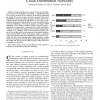Free Online Productivity Tools
i2Speak
i2Symbol
i2OCR
iTex2Img
iWeb2Print
iWeb2Shot
i2Type
iPdf2Split
iPdf2Merge
i2Bopomofo
i2Arabic
i2Style
i2Image
i2PDF
iLatex2Rtf
Sci2ools
95
Voted
ISCAS
2006
IEEE
2006
IEEE
Design methodology for global resonant H-tree clock distribution networks
Abstract—Design guidelines for resonant H-tree clock distribution networks are presented in this paper. A distributed model of a two-level resonant H-tree structure is described, supporting the design of low power, skew, and jitter resonant H-tree clock distribution networks. Excellent agreement is shown between the proposed model and SpectraS simulations. A case study is presented that demonstrates the design of a two-level resonant H-tree network, distributing a 5-GHz clock signal in a 0.18- m CMOS technology. This example exhibits an 84% decrease in power dissipation as compared to a standard H-tree clock distribution network. The design methodology enables tradeoffs among design variables to be examined, such as the operating frequency, the size of the on-chip inductors and capacitors, the output resistance of the driving buffer, and the interconnect width. A sensitivity analysis of resonant H-tree clock distribution networks is also provided. The effect of the driving buffer out...
Related Content
| Added | 12 Jun 2010 |
| Updated | 12 Jun 2010 |
| Type | Conference |
| Year | 2006 |
| Where | ISCAS |
| Authors | Jonathan Rosenfeld, Eby G. Friedman |
Comments (0)

